
From the urban office worker to the village boatman, many people's lives are changing -- for better or for worse -- with the growing influence of China in the Mekong region. This situation has produced a mixed set of reactions.
A hotel manager in Phuket says he is eager to learn basic Mandarin to serve more Chinese customers, but he also feels put off by their noisy and unruly reputation.
A Bangkok white-collar worker, also a self-proclaimed bookworm, says he's read a lot about China and appreciates its impressive history. However, he confessed to feeling threatened by the powerful sway of China over Thai business practices.
Despite political tension between China and Vietnam's governments over the South China Sea dispute, a Vietnamese friend of mine told me she's discovered an entrepreneurial way to forge business between the countries. She purchases cheap clothes from an online Chinese dealer, then resells them in her local market.
A durian farmer in Rayong attests to enjoying a better income from selling his fruit to Chinese merchants, who will pay higher prices than locals -- about 90 to 100 baht per kilogram in comparison to the regular Thai price of 70 baht.
However, the new hiked-up prices have upset his long-time local customers.
On the other hand, the income of Thai compost producers is declining as several key ingredients, including durian husk and other fruit peels, are being bought off and sent on transport trucks bound to China via Laos' R3A highway.
These changes sweeping the country reflect the Red Dragon's descent on the Mekong region, a part of China's recent push to expand its global economic influence.
On Nov 14, Chinese Premier Li Keqiang proposed the subregional Lancang-Mekong Cooperation (LMC), an initiative to improve interconnectivity and cooperation among its six member countries -- China, Cambodia, Laos, Myanmar, Thailand and Vietnam.
The proposal was supported by various Mekong leaders, leading to the first official meeting of the LMC in March last year.
At the meeting, Mr Li vowed to provide US$1.54 billion in loans and up to $10 billion in credit lines to fund infrastructure and improve transport networks in the Mekong region, including railways, waterway, ports and air transport infrastructure.
The meeting was later followed up with an LMC ministerial meeting in Siem Reap, Cambodia, on Dec 23.
Four days later, the Thai cabinet approved a plan to develop infrastructure to improve water transport in the Mekong River between 2015 to 2065 alongside other LMC countries.
Achieving the project's goals means that the Mekong River's rocks will be blasted to allow commercial ships with a 500-tonne carrying capacity to pass through a channel from Yunnan in China, Luang Prabang in Laos to Chiang Rai in Thailand all year round.
Currently, only ships with 100-300 tonnes in carrying capacity can pass through Mekong River due to natural rapids that obstruct the water transport route during dry season.
The project was met with protests by a Thai village community living along the river, concerned about the environmental damage and impact on local livelihoods it would inflict.
Despite the latest public outcry, the incentive to improve the Mekong's navigation channels has long been around, with the idea first emerging in Thailand 20 years ago.
When I asked ordinary people about nailing the right approach to dealing with China's presence in the Mekong, our conversation would often go along the lines of: "We must negotiate with China." But they got worn out thinking about how to go about these negotiations, weary of the country's size and power, concluding: "It's not that easy."
ECONOMIC GIANT
Chadin Chiepleam, 64, is a boatman who navigates a tourist ship through Khon Pi Long, a series of rapids along a 1.6-kilometre section of the Mekong River dividing Chiang Rai and Bokeo province in Laos.
The name of the rapids means "where the ghost lost its way".
Its name refers to old accounts of dead bodies being found washed up in the rocky area due to the water's strong eddies.
During the dry season, Khon Pi Long is a major obstacle for big-sale commercial ships to navigate. It's a law of nature that limits the number of people who can reap the benefits of the river, including locals who earn money from fish that lay eggs in that part of the river.
Originally from Chiang Khong in Chiang Rai, Mr Chadin knows this stretch of the river and the movements of the rapids by heart. His ability to deftly navigate the rapids and rocks is what first opened up the passage to Chinese business developers in the early 2000s. Around that time, a group of Chinese people travelled to Chiang Rai in search of a navigator who could guide them down the river from Chiang Rai to the Chinese-Lao border. Mr Chadin was recommended to accompany them.
The trip took over 10 days. It was only afterwards that Mr Chadin realised that the Chinese visitors had come to survey and take notes on navigating the river for a China-backed navigation improvement project.
The development of the Mekong infrastructure project had already been taking place behind the scenes then.
When the LMC came together, the project finally emerged in the public eye.
Mr Chadin became aware that the new infrastructure would destroy the Khon Phi Long rapids.
It would mean that his exceptional ability to navigate the rocks and rapids may no longer be needed, he said.
"Only a handful of local people here, maybe less than 10 and mostly old, have the ability to navigate boats through upstream Mekong. It's not an interesting job for young people," he said.
Following the trip, Mr Chadin began to notice that China had been taking notes on the river all along.
The Upper Mekong hydropower dams were set up in China's territory 20 years ago. The downstream water levels and movements are no longer shaped by natural seasons. With this came the disappearance of many fish species. Vegetables farms at the river bank became vulnerable to inundation overnight -- in any given season.
Fishermen were forced to change their jobs to escape poverty.
At the same time, demand for power became heightened in China, Laos and Myanmar in the poverty-stricken border areas.
The R3A highway, running from Thailand through Laos to China, was opened in 2008 after the Greater Mekong Subregion Economic Corridor Cooperation programme was established.
The fourth Thai-Lao Friendship Bridge was opened in 2013, connecting China's Kunming province to Laos and the Thai district of Chiang Khong in Chiang Rai province.
During Chinese New Year, Thai locals begun to see a new influx of Chinese caravans.
In 2011, a new Chiang Saen commercial port begun its operation. Border trade increased thanks to the new infrastructure, culminating in the Asean-China Free Trade Agreement, effective as of 2010.
Last year, over 3,500 commercial ships arrived at the Chiang Saen commercial port. The vast majority of these ships were Chinese and Lao vessels hired by Chinese businessmen. Only one was Thai, according to local people's observations. Chiang Saen Customs reported that last >> >> year, 99% of goods imported through them were from China, valued at 704 million baht -- up from the 483 million baht recorded in 2012.
The top imported goods were garlic, sunflower and pumpkin seeds, and pomegranate. Garlic from China became a more pronounced part of locals' cooking habits as a result.
At the same time, the top export products at Chiang Saen Customs were frozen chicken parts and pig.
Exports to China at the customs service earned 2.8 billion baht in value, accounting for around 19% of all exports. Another 18% of exports, equivalent to 2.8 billion baht, went to Myanmar, while 63%, or 9.5 billion baht, went to Laos. There is no available figure for goods directly shipped to China from Laos.
In a Chiang Rai town, locals found a Chinese-operated contract banana farm deploying a heavy amount of chemicals in their produce. Meanwhile, Chinese investors showed an increasing interest in the Thai government's new developments of a special economic zone, which has yet to be specifically defined, in Chiang Khong.
"What can I say? Well, China is very big," said Mr Chadin as he laughed off the situation.
The laugh rings as of a slight nervousness that I can see in many people I interview about China's expanding reach.
They want to resist but they feel too small.
ASSOCIATING WITH CHINA
"The size of China is enormous. It makes people cautious," said Aksornsri Phanishsarn, a Thai-Chinese relations expert at Thammasat University's faculty of economics. She's referring to the size of China's economic power and influence.
China's 2015 level of foreign direct investment (FDI) was ranked as second only to the US in the world as a result of government policies and the Belt and Road Initiative, known as the new Silk Road, that combines new infrastructure networks on land and maritime routes to link the Chinese economy with the Eurasia region.
In 2015, FDI outflows to the Belt and Road countries and regions were $18.9 billion. They reached $400 million in 2004, making the FDI outflows 43% of annual average growth in the target areas.
In Asean, Chinese investment grew by 200% between 2008 and 2014.
The Ministry of Commerce reported that China had the highest share, or 10.8%, in Thailand's export market, only trailing the US, between January and November of last year.
China was ranked as the first for seizing the highest share, or 21.7%, of the Thai import market. It also has the highest share of trade value of 16%, equivalent to 2 trillion baht.
But since 2015 China has experienced a slowdown in its economic growth.
The effects were felt in many countries, including Thailand, which depend on exporting goods such as electronic parts and raw materials serving China.
"We are just one joint of China's supply chains," Ms Aksornsri explained. "The current structure of Thai-Chinese trade is a problem. The government must place more of a priority on producing things that can be sold to China rather than feeding its exports."
China's economic slowdown reinforced the fact that it has significant impact at both global and local levels.
"China is a giant dragon that we can't just disassociate with. The question is how we will proceed to get along with. To deal with China, we must be prudent -- not rush relations -- and show dignity," said Ms Aksornsri.
The Mekong remains southern China's bridge to the rest of Asean, home to abundant natural resources, a growing middle class and consumption power attractive to Chinese investors.
Jack Ma, Alibaba CEO and Chinese billionaire, reportedly expressed heightened interest in the Asean market during the G20 summit in Hangzhou last year.
In particular, Mr Ma is reportedly interested in Thailand's online market, with social media users stacking up, and Indonesia, with its burgeoning population of 260 million.
China has done its best to play the role of a good neighbour to Mekong countries.
In the first LMC meeting last year, Premier Li stated that member countries will enjoy a win-win situation where benefits are collectively shared.
But the top-down approach of China's foray into the Mekong has lent itself to different opinions on the ground level. Some have criticised China for trying to "take advantage" of small countries.
Many Chinese development projects, ranging from copper mines in Myanmar to paper pulp mills and thermal power plants in Vietnam to heavy-chemical banana farms in Thailand, have raised environmental concerns.
Some people I met perceived emerging of Chinese investors in their home as being a "threat to sovereignty".
With mounting caution concerning China, Ms Aksornsri says that it has begun to pick up on public sentiment and slow their momentum to ease into these new economic relationships.
The recently suspended Myitsone Dam project in Myanmar, funded by the Chinese, is a case study in political caution. The project became a controversial subject because it was located in Kachin state, a heavily militarised area, and electricity would have been directed to Yunnan. China was criticised for ignoring local concerns.
WIN SOME, LOSE SOME
Many people have felt resentful that their voices have not been not taken into consideration when it came to government-to-government Chinese investment.
An academic essay on China-Chiang Rai relations by Pollavat Prapattong, a liberal arts lecturer for Mae Fah Luang University in Chiang Rai, describes the Chinese investment approach as an attempt to "make [the town, environment and so on] China for the Chinese,"
"Public participation is an approach that has been left out of China's development over the last three decades," said Brian Eyler, director of the Southeast Asia Programme at the Stimson Center.
"The central government saw it as unnecessary because China's economic machine could absorb those shed from rural areas and displaced by large infrastructure projects. To advance infrastructure development in a more sustainable and inclusive way, Chinese developers and national and local governments in the Mekong region could do much more to improve public participation during the various stages of infrastructure project implementation."
Mr Eyler cites a case study in Laos as an example. Here, entire towns are being redesigned to make way for China-bound railroads. The suburbs of Luang Prabang and Vientiane are slowly beginning to resemble parts of Yunnan province.
The central Chinese government requires that overseas investors improve their environmental and corporate social responsibility practices. But enforcement only takes place in a limited number of firms within the state's reach.
"I think negative views of China will always cast suspicion and doubt on China's designs for the region," Mr Eyler said.
"China must clear many high hurdles to demonstrate to the region wholesale that its projects are sustainable, both commercially and environmentally."
China has reaped many benefits from expanding its trade and investment into the Mekong region, and also, he said, used diplomacy to prevent Asean bandwagoning against it in the South China Sea dispute.
It's hard to determine if ordinary people will gain from China's new infrastructure in the Mekong. Either way, it is pushing people to adapt in their daily lives.
Prayun Saen-ae, a 55-year-old fisherman in Loei province, sleeps for around two to four hours a day nowadays. He has to work several jobs to earn a living, including rubber tapping, construction work and as a mechanic.
His life was easier before a Chinese dam was built in the Mekong River upstream. He could easily make a living off of fishing. But the Chinese control of the dam gate has affected water flow downstream, leading to declining fish stock.
When asked how he's adapting to this new obstacle, he says: "At least a fisherman like me can decide when I want to fish, when I want to work or sleep. Life must go on in some or other ways."
In front of his old wooden house, I saw some of his mechanic gear had a "Made in China" tag.
Change without the personal desire to adapt is difficult. But after some time, people get used to it. The tides of change wash away their will to resist.
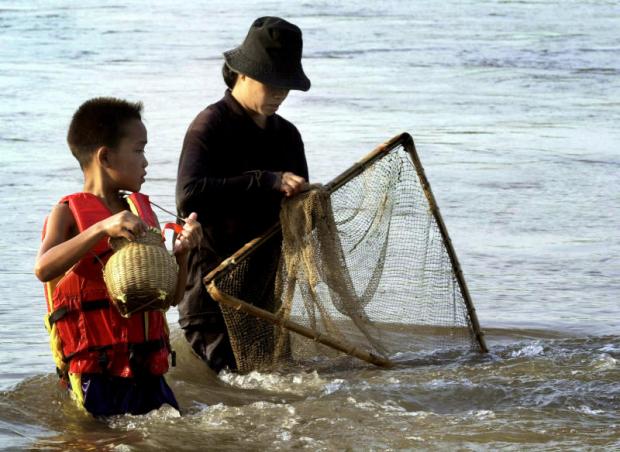
NET GAIN: A mother and her son catch fish in the Mekong River in Chiang Rai's Chiang Saen district. photo: Apichart Weerawong

delivering the goods: Garlic from China is taken to markets from the Chiang Saen pier in Chiang Rai. Last year, 99% of goods imported through Chiang Saen came from China, say customs records. photo: Sarot Meksophawannakul
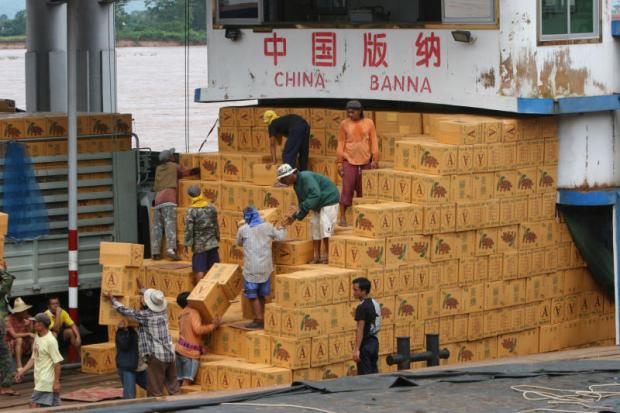
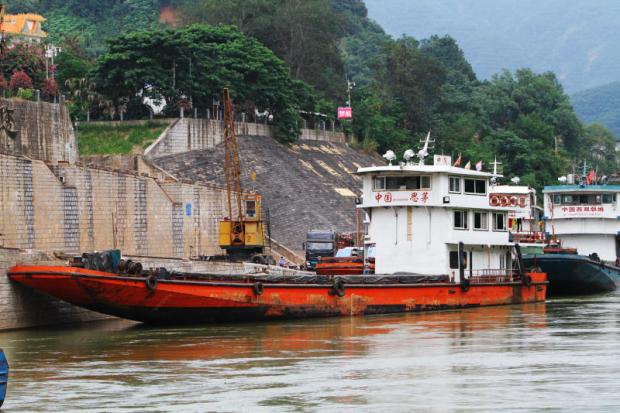
setting sail: A Chinese boat from Guan Lei port in Yunnan province sails along the Mekong River en route to Thailand to deliver goods.

MIGHTY: The Mekong River winds its way downstream through the foothills of the remote mountains of southwest China's Yunnan province. photo: afp

SERENE: A fishing boat passes near a construction site of the Don Sahong dam near the Cambodia-Laos border, northeast of Cambodian capital Phnom Penh. photo: ap
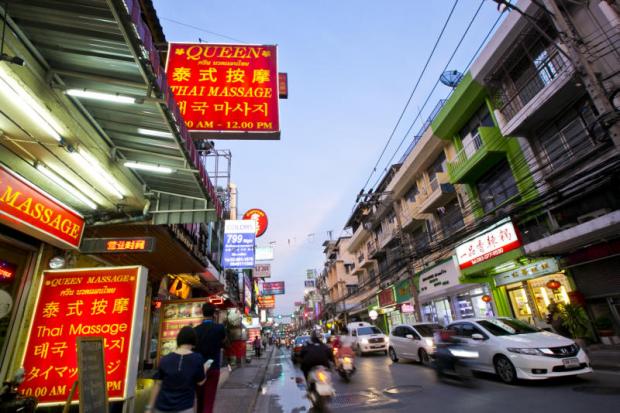
photos: Krit Phromsakla Na Sakolnakorn
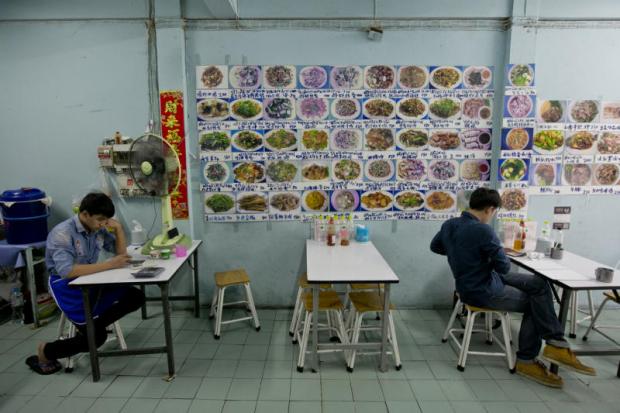
culture: Bangkok's new Chinatown in Huai Khwang boasts growing numbers of Chinese restaurants, including Yunnan cuisine, alongside southern Chinese-style confectionery shops and beauty salons.